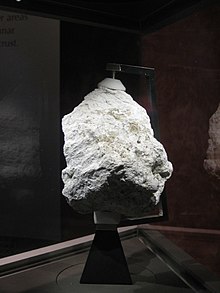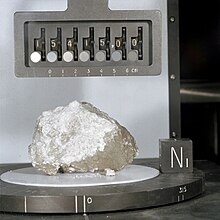User:Qvitellihawk/Ferroan anorthosite
| This is the sandbox page where you will draft your initial Wikipedia contribution.
If you're starting a new article, you can develop it here until it's ready to go live. If you're working on improvements to an existing article, copy only one section at a time of the article to this sandbox to work on, and be sure to use an edit summary linking to the article you copied from. Do not copy over the entire article. You can find additional instructions here. Remember to save your work regularly using the "Publish page" button. (It just means 'save'; it will still be in the sandbox.) You can add bold formatting to your additions to differentiate them from existing content. |
Article Draft
[edit]Ferroan anorthosite (FAN) is a pristine coarse-grained igneous rock found in the lunar highlands. FANs have a Ca-rich plagioclase (called anorthite) composition greater than 90 wt%,[1] with many consisting of an anorthite-content of 99 wt%[2]. The first hand sample of FAN was discovered at the Apollo 15 landing site, Hadley-Apennine. FANs were also found at the Apollo 16 landing site, the Descartes Highlands. FANs have been used to give insights into the evolution of the early lunar crust. Wood et al. (1970) first proposed that FANs were the result of the flotation of plagioclase crystals in a lunar magma ocean.[3]. However, Wetherill (1975) suggested that FANs formed due to serial magmatism.[4]
Petrology
[edit]FANs are called such because "ferroan" is attributed to the Fe-rich, Na-poor mineral contents found in these rocks, while "anorthosite" is in relation to the high content of anorthite. In addition to anorthite, FANs also contain high- and low-Ca pyroxene, and traces of olivine, ilmenite, and ulvöspinel.[5][6]
| (vol%) | 15415[2] | 60015[7] | 67075[5] |
|---|---|---|---|
| Anorthite | 99 | 98.5 | 99 |
| Pyroxene | 1 | 1.5 | 1 |
| Olivine | tr. | tr. | tr. |
| Ilmenite | tr. | tr. | tr. |
| Spinel | tr. | tr. | tr. |
*Talk about lamellae in pyroxene crystals*
FANs were initially rocks with only coarse-grain size crystals,[8] but most samples have been severely shocked from eons of meteoroid impacts into the lunar surface.[9][10] Therefore, many FANs are brecciated clasts and are do not represent their primary condition.[1] However some samples still house their original texture, like Sample 60025.

*Talk about REEs and age dating*
Locations
[edit]*Discuss the Apollo 15 and 16 landing sites*



Origins
[edit]The initial coarse-grain size of FANs is due to them being plutonic, crystallizing beneath the surface.
References
[edit]- ^ a b Dowty, Eric; Prinz, Martin; Keil, Klaus (1974-11-01). "Ferroan anorthosite: A widespread and distinctive lunar rock type". Earth and Planetary Science Letters. 24 (1): 15–25. doi:10.1016/0012-821X(74)90003-X. ISSN 0012-821X.
- ^ a b Stewart, D.B. (1975). "Apollonian Metamorphic Rocks -- The Products of Prolonged Subsolidus Equilibration". Abstracts of the Lunar and Planetary Science Conference. 6: 774–776.
- ^ Wood, J. A.; Dickey, J. S. Jr.; Marvin, U. B.; Powell, B. N. (1970). "Lunar anorthosites and a geophysical model of the moon". Geochimica et Cosmochimica Acta Supplement. 1: 965–990.
- ^ Wetherill, G. W. (1975). "Possible Slow Accretion of the Moon and its Thermal and Petrological Consequences". Abstracts of Papers Presented to the Conference on Origins of Mare Basalts and their Implications for Lunar Evolution: 184.
- ^ a b Steele, I.M.; Smith, J.V. (1973). "Mineralogy and petrology of some Apollo 16 rocks and fines: General petrologic model of moon". Proceedings of the Lunar Science Conference. 4: 519–536.
- ^ Brown, G.M.; Peckett, A.; Phillips, R.; Emeleus, C.H. (1973). "Mineral-chemical variations in the Apollo 16 magnesio-feldspathic highland rocks". Proceedings of the Lunar Science Conference. 4: 505–518.
- ^ Dixon, J. R.; Papike, J. J. (1975). "Petrology of anorthosites from the Descartes region of the moon - Apollo 16". Lunar Science Conference, 6th, Houston, Tex., March 17-21, 1975, Proceedings. 1: 263–291.
- ^ McGee, J. J. (1993-05-25). "Lunar ferroan anorthosites: Mineralogy, compositional variations, and petrogenesis". Journal of Geophysical Research: Planets. 98 (E5): 9089–9105. doi:10.1029/93JE00400. ISSN 0148-0227.
- ^ Alibert, Chantal; Norman, Marc D.; McCulloch, Malcolm T. (1994-07-01). "An ancient Sm-Nd age for a ferroan noritic anorthosite clast from lunar breccia 67016". Geochimica et Cosmochimica Acta. 58 (13): 2921–2926. doi:10.1016/0016-7037(94)90125-2. ISSN 0016-7037.
- ^ Norman, Marc D.; Borg, Lars E.; Nyquist, Lawrence E.; Bogard, Donald D. (2003-04). "Chronology, geochemistry, and petrology of a ferroan noritic anorthosite clast from Descartes breccia 67215: Clues to the age, origin, structure, and impact history of the lunar crust". Meteoritics & Planetary Science. 38 (4): 645–661. doi:10.1111/j.1945-5100.2003.tb00031.x. ISSN 1086-9379.
{{cite journal}}: Check date values in:|date=(help)
